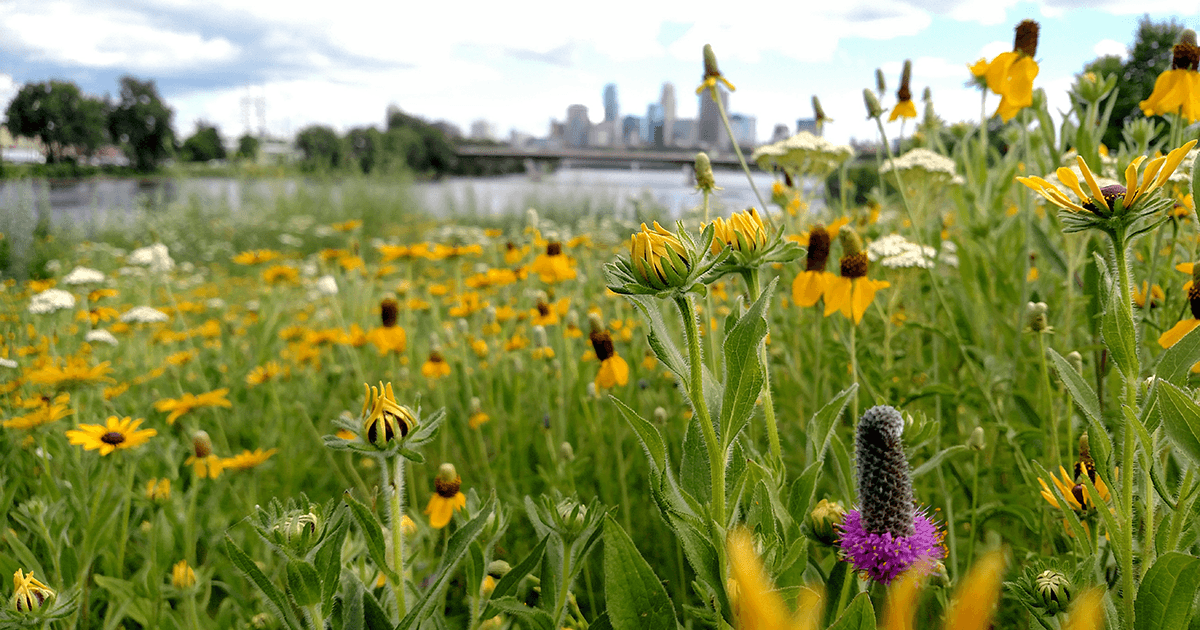Native plantings for the river

Birds, pollinators and other critters depend on native wildflowers and plants for habitat, and even the smallest yard's native plantings can make an impact. (Check out Habitat in the city: the power of the single yard to learn more.)
Many native plants help water quality too. To endure Minnesota's hot summers and deep-freeze winters, prairie grasses like big bluestem grow roots down to 8 feet to reach nutrients and water. These deep roots hold soil in place and allow the earth to absorb far more rain than turfgrass lawn can.
Whether you want to create a whole native garden or just add a few native plants, here are some helpful tips.
Preparing your site
Make sure the area you choose is weed-free. You can remove sod or plan to start fresh by smothering out weeds for a full growing season.
Once your plot is prepped, get plugs from local native plant suppliers. Choose grasses like little bluestem and wildflowers like milkweed that are beneficial to animals and the river alike. (See below for more recommendations.)
If you spent the last year prepping your plot, plant plugs in the spring and water them through any dry periods as they establish.
Fall is also a great time to plant native plants in well-drained, sunny plots. Your autumn planting window usually runs from September through October. Plugs will go dormant, then grow in spring. If you're working on a larger area, or in a less formal garden setting, consider dormant seeding your prepped plot in the late fall, and letting those seeds go through their natural freeze-thaw cycles before germinating in the spring.
Gardening tips for fall, winter and early spring
Leave last year's leaves where they fall in the fall. Not only do old leaves help retain soil moisture, suppress weeds and provide nutrients, they also protect overwintering bumblebees, which need the insulating leaf layer.
If you're cutting back your garden, leave one to two feet of standing dead stalks to provide nesting cavities for pollinators and other insects. The remaining standing dead material will eventually be hidden by the plants' new growth. We know it's tempting, but don't start your garden work too early in the spring. Wait until night-time temperatures are in the 50s — usually early to mid-May — to allow insects to wake for the season." If you cut stalks, leave them in a stack for a few weeks to allow any nesting insects to emerge.
Choosing native plants
Not sure where to start? Here are a few select species that are especially good for urban gardens.
Early blooms
• Violets (purple) Viola sp
• Columbine (red) Aquilegia canadensis
• Wild lupine (blue) Lupinus perennis
• Prairie onion (pink) Allium cernuum
• Prairie coreopsis (yellow) Coreopsis palmata
Midseason blooms
• Purple prairie clover (purple) Dalea purpurea
• Wild bergamot (lavender) Monarda fistulosa
• Culver's root (white) Veronicastrum virginicum
• Swamp milkweed (pink) Asclepias incarnata
• Butterflyweed (orange) Asclepias tuberosa
• Wild anise (purple) Agastache foeniculum
Late-season blooms
• Prairie coneflower (yellow) Ratibida pinnata
• Blazing star (pink) Liatris ligulostylis
• New England aster (purple) Symphyotricum novae-angliae
• Showy goldenrod (yellow) Solidago speciosa
Shrubs
• American plum (large) Prunus americana
• Smooth rose (small-med) Rosa blanda
• False indigo (large) Amorpha fruticosa
• Elderberry (small-med) Sambucus sp
• Juneberry (medium) Amelanchier sp
• Dogwood varieties: Pagoda, gray and red osier (small-large)
Shade plants
• Wild geranium (pale violet) Geranium maculatum
• Zig zag goldenrod (yellow) Solidago flexicaulis
• Columbine (red) Aquilegia canadensis
• Large-leaved aster (lavender) Eurybia macrophylla
• Large-flowered bellwort (yellow) Uvularia grandiflora
Additional resources
• Minnesota Wildflowers website: Detailed information about many native Minnesota plants
• Blue Thumb plant finder
• Mississippi Watershed Management Organization's spring yard care and fall yard care webpages
• Minnesota Department of Natural Resources guide on using native plants for landscaping and restoration
• Minnesota Department of Natural Resources list of native plant suppliers, information on shoreline restoration, and guide to invasive species
• Minnesota Board of Water and Soil Resources pollinator planting toolbox
• FMR's webpage on raingardens
• U of M Extension's recommended climate-ready plants by region
Landscape for the river
Dig into more tips to help protect the river right from your own backyard.